2016 Tata Hexa review, test drive
With the Hexa, Tata opens a new chapter in the premium SUV segment. Here are our first impressions of the car.
Updated on Feb 07, 2017 01:50:00 PM
78,768 Views
Follow us on



What is it?
Image is everything. And Tata Motors, stuck with the image of being a budget carmaker is determined to change this perception. With the success of the Tiago in the market, Tata is now targeting a more demanding set of premium buyers with the new Hexa. At one level, the Hexa is Tata Motors’ new flagship aimed squarely at the Mahindra XUV500 but at a larger level, this model will be the acid test for the brand in the upper echelons of the market. Is the Hexa up to the task?
What is it like?
| Tata Hexa Price, Mileage, Specifications, Features and Variants | |
|---|---|
| Brand | Tata |
| Model Name | Hexa |
| Tata Hexa Price | NA |
| Tata Hexa Range/Mileage | Diesel : 14.4kpl |
| Tata Hexa Specifications | Crossover | 5 doors | 7 seats View All Specs |
| Tata Hexa Features | Halogen headlight | 5-inch Touchscreen display | 6 airbags View All Features |
| Tata Hexa Variants | 2.2 Varicor 320 XE (7 Seater) | 2.2 Varicor 400 XM (7 Seater) | 2.2 Varicor 400 XM+ (7 Seater) View All Variants |
The Hexa is based on the Aria platform and that’s no bad thing as it gets the benefit of a ‘hydroformed’ ladder chassis that is rigid and tough. Other than in side profile, where the carryover roof and glasshouse is obvious, there isn’t much of a visual link to the Aria – each body panel is new.
Where the Aria’s part-SUV-part-MPV design seemed lost in translation, the Hexa makes a much bolder impression. Tata won’t go so far as to call the Hexa an SUV, but that’s clearly the look it has gone for. There are lots SUV design cues, like the black cladding that runs around the car and well chiselled angular details on the body.

The chunky clamshell bonnet, upright grille (nicely detailed with hexagons) and stretched-back headlamps gel really well. Adding the desired dose of aggression without looking overdone is the stylish front bumper that houses a large central air dam and comes embellished with attractive daytime-running LED lights.

There are no undue cuts and creases on the sides and the resulting look is one of robustness. LED elements for the brake lights, boomerang-shaped reflectors on the bumper, dual exhausts and a large scuff plate also does a lot for the Hexa’s strong-shouldered look. The Hexa’s certainly got the size (it’s 4,788mm long and 1,791mm tall) and the ground clearance (200mm) to pass off as the more rugged of the species.
The 19-inch wheels are the largest in class but amidst the vast body, they look a bit sunken which spoils the stance a bit.
What's it like inside?
It’s quite a step up into the Hexa’s high-set cabin but once inside you’ll have to remind yourself you are in a Tata. What you get are some of the best seats in the business and a superb level of quality you would find hard to associate with Tata cars. The carmaker’s investment in getting the look and feel right has reaped rewards because the cabin scores brilliantly on perceived quality. Right from the knitted roof lining and contrast stitching on the leather seats to the brushed aluminium effect on the side air-con vents and knurled finish on the climate control knobs, there’s a certain premiumness to just about everything. Tata has even gone to the extent of giving the door locks a textured finish! At places, however, panel gaps are larger than warranted but the cabin’s black theme ensures they don’t necessarily stand out.
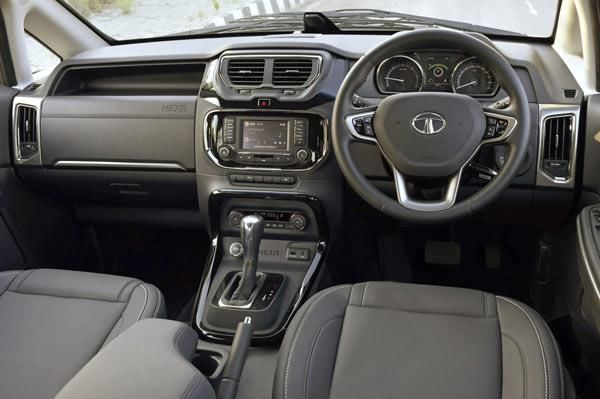
The Hexa’s dashboard is relatively simply styled but it does have a solid look. The centre console is neatly split between the air-con vents, infotainment system and climate control buttons and each section uses a gloss-black trim and chrome detailing to good effect.
But given how in-car connectivity and entertainment have been areas of focus at Tata for a while now, it’s a bit disappointing to know the Hexa shares its infotainment system with the cheaper Bolt and Zest. The 5.0-inch touchscreen looks small in such a wide car.
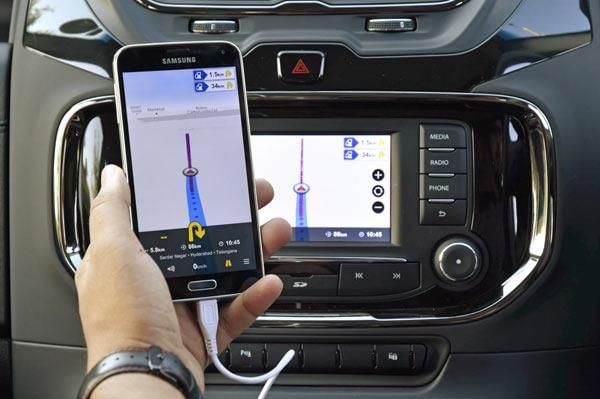
Functionality-wise though, Tata has packed the system with features including downloadable mobile apps for offline navigation, jukebox (songs from multiple phones can be added to a playlist on a primary synced phone), remote control for the audio system, vehicle service and the owner’s manual. As we learned, the apps are quite heavy in terms of battery usage so perhaps Tata could have been more generous with USB ports – there are only two. But you do get three 12V sockets which includes one in the boot.
Fine-tuned specifically for the Hexa, The incredible sounding 10-speaker JBL system delivers immense power and clarity for all three rows of seats. And to set the tone, there is eight colour configurable ambient lighting too! Cruise control, auto headlamps and wipers and reverse camera with dynamic guide lines are also standard. However, a sunroof and push button start, features you now expect, are missing.
The seats are, in a word, brilliant. Well-shaped, richly finished and very supportive, they are one of the highlights on the Hexa. Their multi-density foam offers just the right amount of cushioning which means you can spend hours in them and emerge feeling fresh. Foldable armrests and adjustable lumbar support just add to the comfort quotient. If there’s anything to criticise, it’s that the seats are overly generous! The base is too long for shorter occupants and digs into their legs behind the knees.
The Hexa’s high driving position gives a commanding view out but the thick A-pillar does hamper visibility especially at crossroads. Drivers will like the sight of the full colour 3.5-inch multi-info display between the speedo and tacho and will also take readily to the quality of touch points like the steering wheel, window buttons and switchgear.
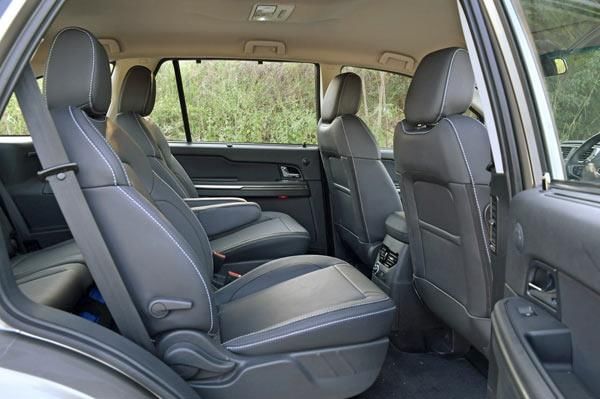
As for the middle row, there’s lots of space on offer but if you want front seat-like comfort in the back, it’s the captain chair option you should go for. Pull-out sun blinds for the large windows and air-con vents on the B-pillar and centre tunnel ensure a good level of pampering. The middle row bench on the seven-seat version is comfy too and the relatively flat contours allow for a third person to fit in comfortably. You can adjust both arrangements of middle seats for backrest angle and move them fore and aft to free up space for the third row. However, access to the last row of seat is not the best – the captain chairs don’t fold fully while the 60:40 split bench requires effort to tumble.
If you’re of average height, the space in the last row is totally useable. The seating position is surprisingly nice as third rows go and there is reasonable room too. Just that it’s not a space for tall people.
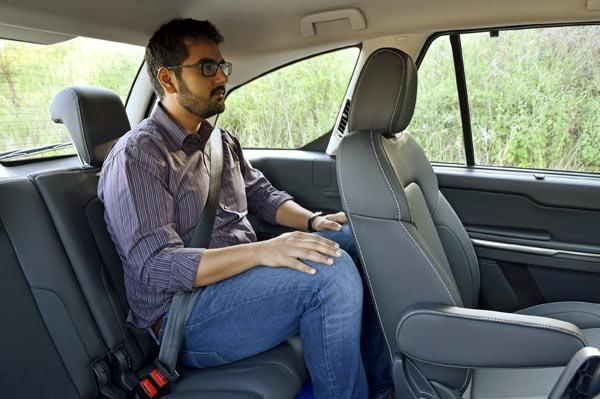
With all seats up, the Hexa’s luggage area can only accommodate a few soft bags but you can fold the third-row backrests (they split 50:50 but don’t fold entirely flat) to free up a lot of room. The Hexa does largely well in terms of in-cabin storage too. There are large door pockets, a handy central storage between the front seats, twin gloveboxes and enough cupholders for the second and third rows. Unfortunately, there’s only a single cupholder right up front and also no dedicated space to keep your mobile phone near the centre console.
What's it like to drive?
The Hexa is the first model after the latest iteration of the Safari to use Tata’s new Varicor400 engine. This unit’s 2,179cc makes a healthy 156hp and 400Nm (hence the ‘400’ in the engine name), but the figures are not so impressive when you account for the fact that the motor also has to lug 2.2-tonnes plus. The engine can be had mated to a new six-speed manual gearbox offered in 4x2 and 4x4 versions, as well as with a six-speed automatic transmission that sends power solely to the rear axle.
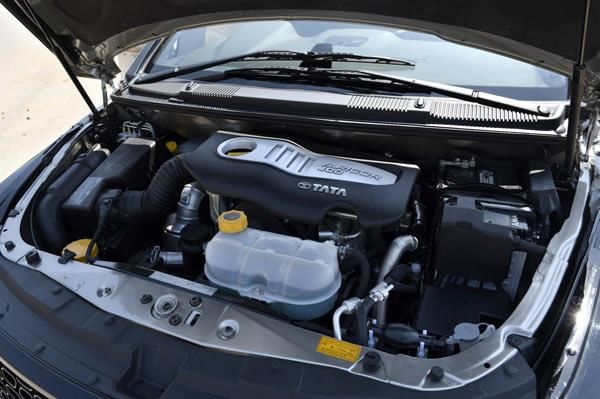
It was the latter we sampled first and it immediately impressed us. The engine is surprisingly responsive and has a nice, linear spread of power, pulling cleanly from about 1,500rpm. There’s no spiky mid-range surge, just a mild swell of torque across a very broad rpm band. Automatic gearshifts are quick, smooth and very fluid and it makes the most of the Hexa’s performance. In fact, the automatic is substantially quicker than the manual and a 0-100kph time of 12.71 seconds for such a behemoth is pretty respectable.
The Punch-sourced ’box also offers a Sport mode where the system only upshifts at the redline and you also have the option to shift manually using the gear lever itself, and it must be said the gearbox is quick to respond. Before you think otherwise, the Hexa isn’t a sporty car but it’s nice that the gearbox has provisions to make the driving experience more involving. Where the Hexa auto feels its best is cruising out on the highway, when the sufficient power and good engine refinement come into play.
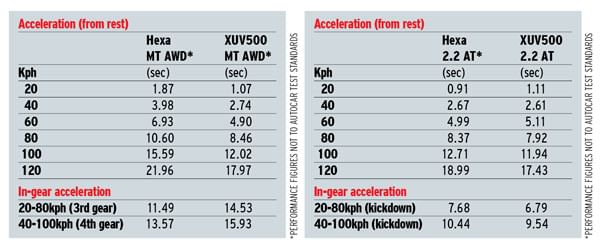
After the automatic, the manual Hexa turned out to be a let down and isn’t half as nice to drive as the auto. The issues, really, are centred around the gearbox and clutch. The six-speed manual has long throws and the gearshifts are rubbery. What makes matters worse is that the clutch action is not progressive making it hard to modulate at slow speeds.
If not on the drag strip, the Hexa will impress on an off-road course. The Hexa’s all-wheel-drive system is latently rear-biased but will send power to the front axle when it senses a loss of grip. There’s hill descent control too. The safety suite too is very comprehensive and includes six airbags and ESP with rollover mitigation.
The Hexa is a large vehicle and feels its size in tight city confines. The steering calls for much effort at low speeds and U-turns are pretty cumbersome. The wooden-feeling brakes too don't inspire confidence and there’s always the sense that the Hexa’s weight will overwhelm the all-round disc brakes. However, we repeatedly simulated a panic-stop braking from 80kph to standstill, and each time the Hexa came to a halt without any drama.
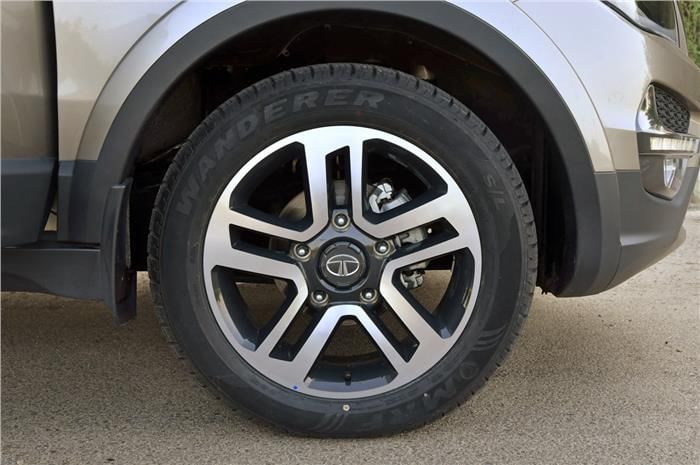
The one area where the Hexa outshines the competition is in ride comfort. The Hexa is the first Tata car to use variable rate dampers and, coupled with the 19-inch wheels, the result is really good. The tyres just bulldoze over small potholes while the suspension happily (read quietly) soaks up any road shock to isolate the passengers. There’s no doubt that the Hexa is easily the best riding vehicle in its segment.
Should I buy one?
Yes, there are a few rough edges and the engineering finesse falls short of the best global standards, but as a standalone product in our market, the Hexa is hugely impressive. Attractive on the outside, well appointed on the inside and feature-loaded, the Hexa strikes a chord at many levels. The big Tata is a supremely comfortable family car and the lavish use of high-grade materials delivers a sense of luxury that would certainly appeal to premium car buyers. We’d give the manual gearbox version a pass and go for the auto instead. It’s not got the 4x4 hardware but as an everyday vehicle it’s easily the better pick.
The Hexa has been priced starting at Rs 11.99 lakh for the base diesel, and it goes all the way up to Rs 17.49 lakh (ex-showroom, Delhi) for the top-of-the-line four-wheel drive variant, which is expensive as Tatas go, but when you see what the money gets you, you won’t be disappointed. The pricing also makes it cheaper than an equivalent Mahindra XUV500, one of the Hexa's main rivals. Tata Motors has added all it can into the Hexa and it's genuinely worth buying.
Copyright (c) Autocar India. All rights reserved.

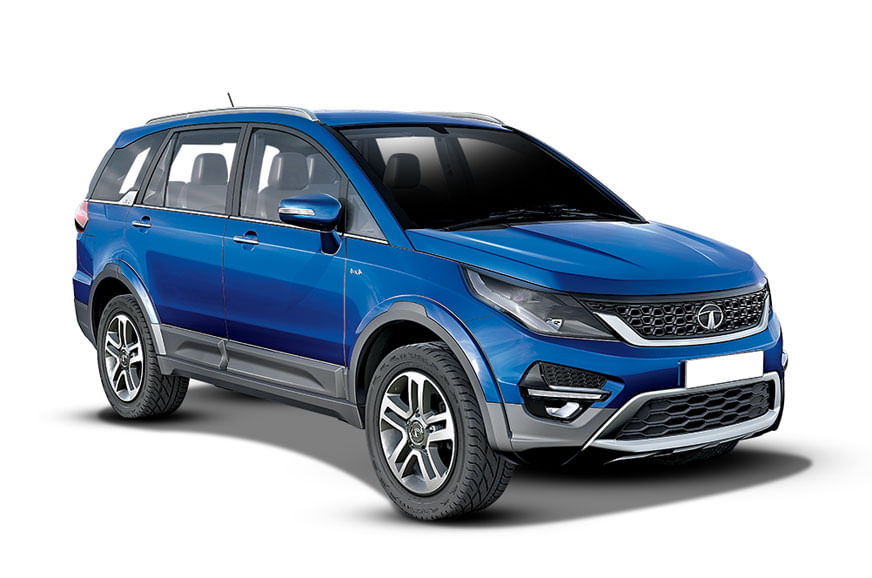

Comments
Member Login
Personal Details
No comments yet. Be the first to comment.